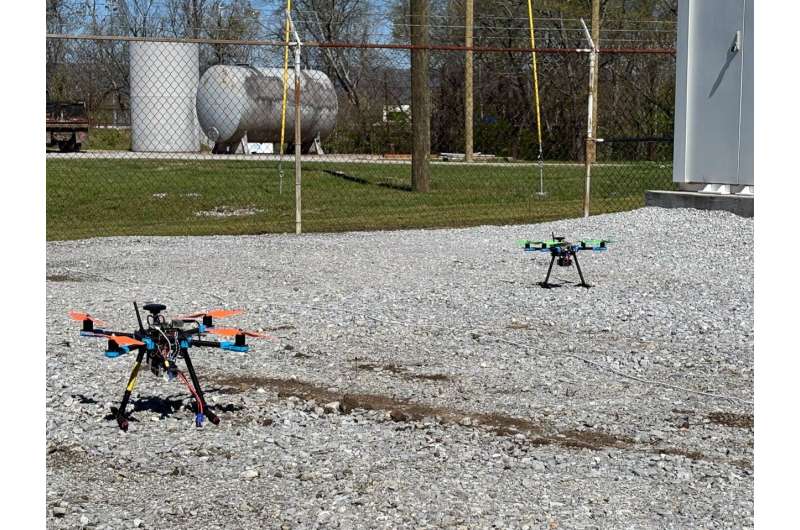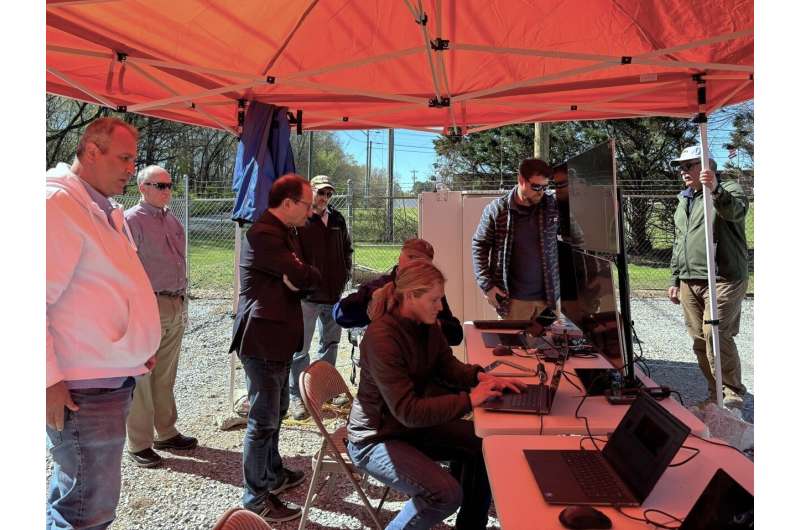A sensor on the electric grid picks up a strange blip in current or voltage. What’s happening, and will it cause an outage? Usually, a utility worker must travel in person to check. Researchers at the Department of Energy’s Oak Ridge National Laboratory have now developed a new automated drone inspection system that can respond rapidly to unusual electric grid behavior, especially in remote areas that are tough for a worker to reach.
ORNL demonstrated the new approach at a training facility for powerline workers owned by utility partner EPB of Chattanooga in Tennessee. A recording of popping sounds, like those made by an arc of superheated electricity, started the exercise. In moments, a drone lifted into the air, following GPS coordinates to check for problems.
Hovering near power lines, the drone filmed the equipment with a tiny camera and then called other drones carrying high-resolution acoustic sensors, radio frequency sensors or other specialized equipment. The drones livestreamed their inspection back to the EPB’s command center and ORNL’s linked Grid Operations and Analytics Laboratory in Knoxville. The drone-mounted sensors can collect enough information for the utility to decide whether to dispatch a bucket truck for urgent maintenance to prevent a power outage.
The demonstration proved that humans don’t have to be directly involved with this level of grid monitoring, said lead researcher Peter Fuhr, who also leads the Grid Sensing and Communications group at ORNL. Drone-based sensors could pinpoint problems faster.
EPB is interested in implementing the approach because accurate, early recognition of electric line malfunctions can prevent outages and save money.
“The biggest opportunity is identifying imminent equipment failure,” said Jim Glass, assistant vice president of Smart Grid Operations for EPB. “Just as with your health, if you catch problems early, you can correct them with less expense and difficulty. Proactively addressing problems before customers experience outages provides tremendous benefit.”
The automated drone inspection and its technology are part of a collaborative project called Autonomous Intelligent Measurement Sensors and systems, or AIMS. ORNL researchers developed the system for using machine-to-machine communications to automatically sense problems, generate work orders and coordinate multi-stage drone inspection of electrical transmission equipment. The project also supports processing the drone data and images so they are useful in rapid decision making.

AIMS customizes off-the-shelf drones, sensors and software along with new technology, algorithms and automated protocols developed by ORNL. Using commercial technology when possible makes the approach practical and affordable for electricity providers.
“This is completely novel to the utility world,” Fuhr said. “No one has put this together as a holistic system before. We’re taking these components and operating them in a very different way, tailoring the math, hardware and software to the needs of utilities.”
In the cases when commercially available products were not affordable for use across a utility system, the ORNL team designed new technology. For example, ultraviolet cameras for the drones were priced at $25,000 and weighed 10 pounds. ORNL researchers invented a combination visual/ultraviolet/invisible light sensor that’s less than 1% of the cost and weighs less than a pound, Fuhr said.
Here’s how the inspection process works: Sensors mounted on power lines and transformers throughout the grid trigger the process when they collect information. The utility’s centralized management system can automatically compare these readings of current and voltage with waveforms in the Grid Event Signature Library, a vast DOE repository of grid data maintained by ORNL.
When irregular activity is identified, a ground control unit can be automatically directed to send a scout drone from an electrical substation. The system can decide which drone is the closest with the appropriate range and battery charge.
The scout drone uses global positioning coordinates to locate and check the area with a radio frequency sensor, visual and infrared cameras and a simple sound detector. The drone can monitor its own battery, dodge obstacles such as trees and power lines, record readings and convey them in real time using wireless or cellular networks—or in the case of the demonstration, via EPB’s fiber optic network.
Based on information collected by the scout drone, the ground control system can send other drones equipped with more specialized inspection capabilities. Fuhr compares the scout drone to an emergency room triage nurse.
“You show up at the ER intake, where a person evaluates your condition and decides if you need a specialist,” he said. “This works the same. The scout decides what type of measurement is needed based on whether there is electrical arcing, a cracked fuse or a branch on a power line.”

Sensor data from the drones, as well as their location and operating status, could be relayed to the central control system in real time. Researchers are working on ways for this processing to occur near the drone, such as at a substation, reducing drain on the battery as well as the risk of interrupted communications. Quantum-based communication will generate random keys that encrypt access to the sensor data and protect drone controls, Fuhr added.
Although this inspection approach is designed to operate independently of human intervention, a built-in override function allows a person to immediately land the drones or send them back to their chargers.
ORNL researcher Elizabeth Piersall adapted the sensor components and developed control software for the drone and cameras. She also created algorithms to recognize dangers to power equipment that are visible in the video feed.
“We want to understand how to use these sensors to accurately identify active arcing, even when dealing with potentially poor resolution and motor vibration from affordable sensors and drones,” she said. To train these models, Piersall has been able to use a vast trove of drone video taken during routine power line inspections through an earlier EPB partnership with the University of Tennessee at Chattanooga.
Fuhr envisions a fleet of drones, each equipped with a different sensing capability, on standby at wireless chargers in substations. EPB has about 100 substations covering 600 square miles of service area, but Glass said he envisions equipping the 20 largest substations first and then adding more as needed. Outfitting substations with the affordable drones ORNL identified would be much more economical than the cost of sending trained line workers in a bucket truck to check far-flung electric lines and equipment.
Glass said EPB has an equal interest in using drones for both routine and emergency line inspection after storms. “The first step in restoration efforts after a major weather event is to assess where the most severe damage is, and drones could be a huge advantage in that.”
Piersall noted that although utilities have thousands of stationary sensors on the grid, those don’t offer an easy way to see elevated equipment close up while it’s operating. “This provides a perspective on the information that utility specialists may not have otherwise,” she said. “We are not just finding a better way to do something that can be done already. We are providing a new capability.”
ORNL researchers Gary Hahn, Ali Ekti, Bill Monday, Jason K. Richards, and Ozgur Alaca and University of Tennessee students Emma Foley and Stephanie Tomasik also contributed to the research.
Citation:
Protecting electric grid health with drone-based power line inspection (2024, August 27)
retrieved 27 August 2024
from https://techxplore.com/news/2024-08-electric-grid-health-drone-based.html
This document is subject to copyright. Apart from any fair dealing for the purpose of private study or research, no
part may be reproduced without the written permission. The content is provided for information purposes only.





